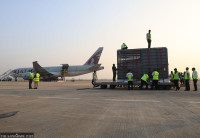Lumbini Province
In Narainapur, the worst appears to be over but fears remain
Narainapur, with 118 cases, had emerged as a hotspot for Covid-19 due to poorly managed quarantine facilities but things have improved in recent days.
Janakraj Sapkota
Lazim Nau of Narainapur Rural Municipality in Banke had gone to a brick kiln looking for work on May 14. He was going to be paid Rs 500 for every thousand bricks he burned. He stayed on the brick kiln premises for a few days, as he didn’t want to walk nine kilometres back home. On the third day, May 17, he was in the midst of burning bricks when a villager arrived with news.
“It was unbelievable. He told me that my eldest son was dead,” 52-year-old Lazim told the Post while standing in the courtyard of his home in Narainapur.
Anish, Lazim’s 25-year-old son, had been in quarantine at the Dipendra Basic School ever since he had returned from Mumbai on May 12. He had come home after the restaurant where he worked closed.
According to officials at the rural municipality, Anish had complained of a headache and had been vomiting since the previous night. Despite his health condition worsening overnight, nobody dared take Anish to the hospital as they suspected he had Covid-19. Anish died at 6:40 am the next morning. When nose and throat swabs taken from Anish tested positive for Covid-19, he became the country’s second fatality from the coronavirus.
Anish’s family believes that he would’ve lived if he had been taken to the hospital on time, as he was young and healthy.
“My brother died because he was not taken to the hospital,” said Farid, Anish’s younger brother. “But whom should we complain to? Who will listen to us?”
Banke, with 255 cases as of Thursday, is among the districts with the highest number of Covid-19 cases. Of these 255 cases, 118 were in the rural municipality of Narainapur alone. And many believe that the poor state of the quarantine facilities has been largely to blame for the explosion of cases.
Krishnachandra Maurya, chair of Ward No 5 in the rural municipality, himself admitted that the number of cases increased in Narainapur as they failed to manage proper quarantine facilities and maintain physical distancing.
On March 18, the local authorities had estimated that around 500 individuals would return to the village from India. The rural municipality accordingly set up four health desks. But over 900 individuals entered Nepal from India in just three days, overwhelming the quarantine facilities.
But ever since the beginning, quarantine facilities have been crowded and mismanaged. There were no health workers and there were problems accommodating newcomers with a shortage of food. There were no health workers deputed to the quarantine facilities, which could’ve helped save Anish’s life.
With cases rising, primarily inside quarantine, on May 10, Narainapur Rural Municipality wrote a letter to the District Administration Office requesting a high-level doctor’s team and more security personnel as the situation was on the verge of spiralling out of control. The rural municipality had also notified the Office of Prime Minister and Council of Ministers, the Home Ministry and the Province 5 government of the same risk.
On May 12, the rural municipality started construction of more quarantine facilities. A total of 19 facilities were constructed in various parts of the rural municipality, housing 978 individuals. Among them, 709 have returned to their homes while 153 remain, and new cases continue to be identified, albeit at a much lower rate.
With the number of people living in quarantine decreasing, district officials said that they have decreased the number of quarantine facilities to just three and improved the state of the facilities.
Inspector Man Bahadur GC of the police post in Bhagwanpur, said that the number of newcomers to Narainapur has decreased since May 24.
“Very few individuals are crossing the border from illegal routes too. We estimate that around 1,200 individuals have entered Narainapur from India since the beginning of the lockdown.” said GC.
According to data from the rural municipality, around 300 individuals have yet to arrive in the coming days from India.
The number of new cases might have decreased but locals say they cannot feel safe until testing is done at the community level. The rural municipality has so far focused on keeping newcomers in quarantine and conducting tests.
“Until now, we have only conducted 11 tests of locals in the village,” said Istiyak Ahmed Sah, chair of the rural municipality. “We are mainly focused on testing individuals who returned from India. But we realise it is necessary to conduct testing of locals.”
According to a security official deployed at a quarantine facility, contact tracing of those who’ve tested positive for Covid-19 has not been done effectively.
“But local officials do not seem to accept this fact,” he said on condition of anonymity. “It is not possible to stay safe until testing is expanded at the community level.”
Meanwhile, Roj Ali, Anish’s youngest brother, remains in quarantine since returning from India, and Lazim remains afraid for his youngest son.




 15.12°C Kathmandu
15.12°C Kathmandu















